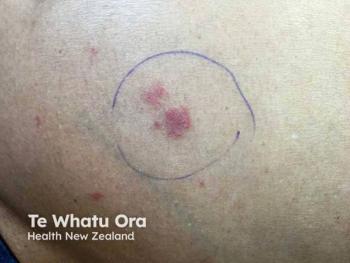
Ruxolitinib Cream vs. Corticosteroids in AD: Commentary on Location-Specific Safety and Continuous Use Potential
Brad Glick, DO, MPH, FAAD, notes the absence of location restrictions with topical ruxolitinib cream, distinguishing it from topical corticosteroids. The panel discusses the cyclic pattern of steroid use and the potential of ruxolitinib cream as a continuous treatment option.
Episodes in this series

This is a video synopsis of a discussion involving James Del Rosso, DO, dermatologist in Las Vegas, Nevada, Brad Glick, DO, MPH, FAAD, a principal investigator at GSI Clinical Research in South Florida, and Lisa Swanson, MD, FAAD, a dermatologist and pediatric dermatologist in Boise, Idaho.
The panelists delve into the versatility and benefits of topical ruxolitinib for treating inflammatory dermatoses, particularly emphasizing its efficacy in addressing disease manifestations on the face. Dr. Del Rosso underscores the importance of providing patients with a comprehensive therapeutic option that can be applied "nose to toes," highlighting the widespread use of the medication on facial areas affected by atopic dermatitis (AD).
Dr. Glick elaborates on the trial data comparing ruxolitinib to triamcinolone, revealing the prolonged efficacy of ruxolitinib beyond the typical duration of corticosteroid treatment. Moreover, the discussion touches upon the potential risks associated with long-term corticosteroid use, including ocular complications, which can be mitigated by opting for non-steroidal treatments like ruxolitinib.
Dr. Swanson echoes the sentiment that non-steroidal treatments offer a significant advantage over corticosteroids, particularly in minimizing the risk of adverse effects and addressing patient concerns surrounding steroid phobia. She emphasizes the continuity of treatment provided by ruxolitinib compared to the intermittent sawtooth pattern associated with corticosteroid therapy.
Furthermore, the panelists discuss the convenience and safety of ruxolitinib in various treatment scenarios, highlighting its applicability to different areas of the body without the concern of unintended side effects. Overall, they conclude that ruxolitinib represents a significant advancement in dermatologic therapy, offering patients a potent and well-tolerated alternative to traditional corticosteroid treatments.
Video synopsis is AI-generated and reviewed by Dermatology Times® editorial staff.
Newsletter
Like what you’re reading? Subscribe to Dermatology Times for weekly updates on therapies, innovations, and real-world practice tips.






















